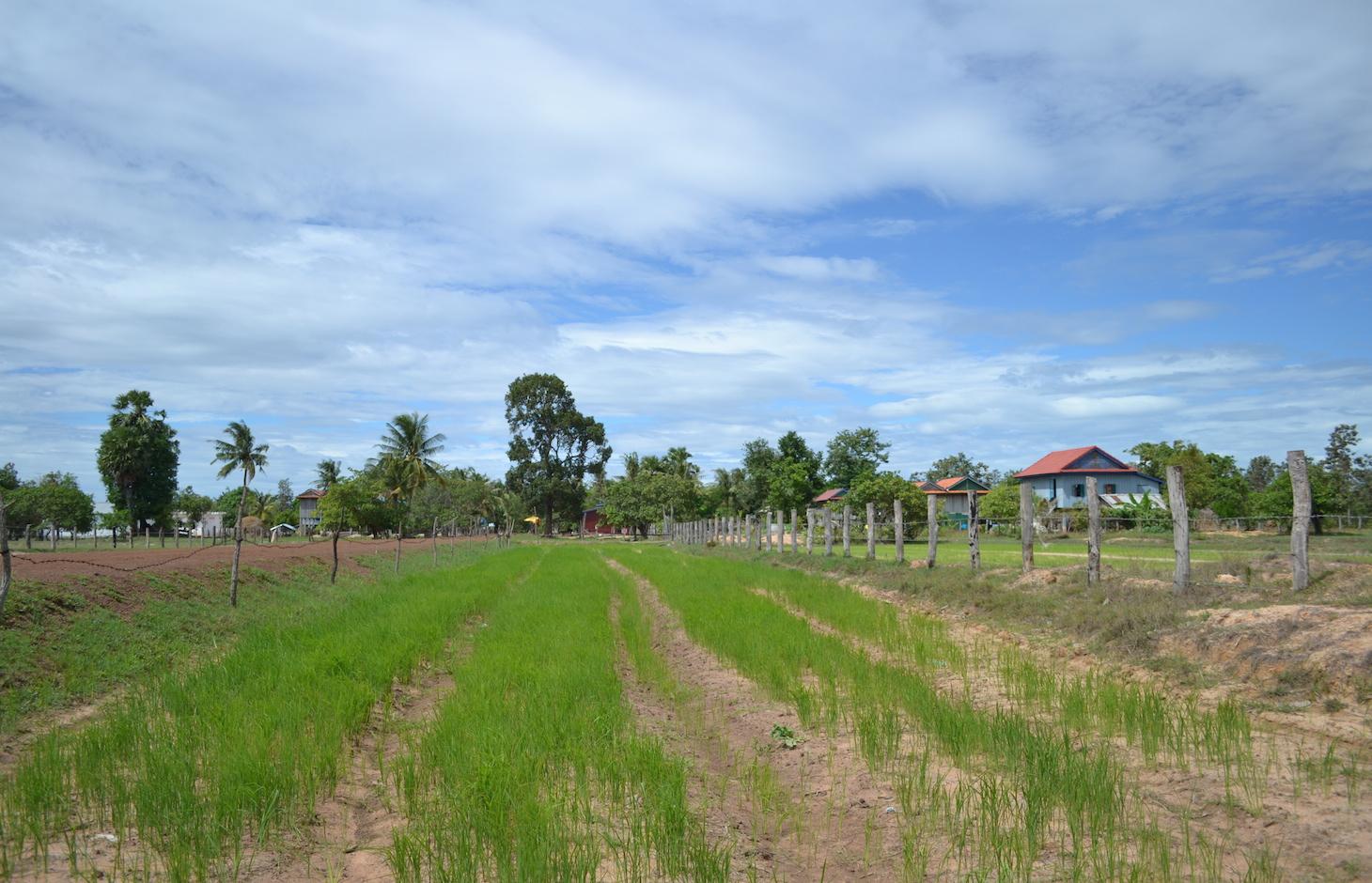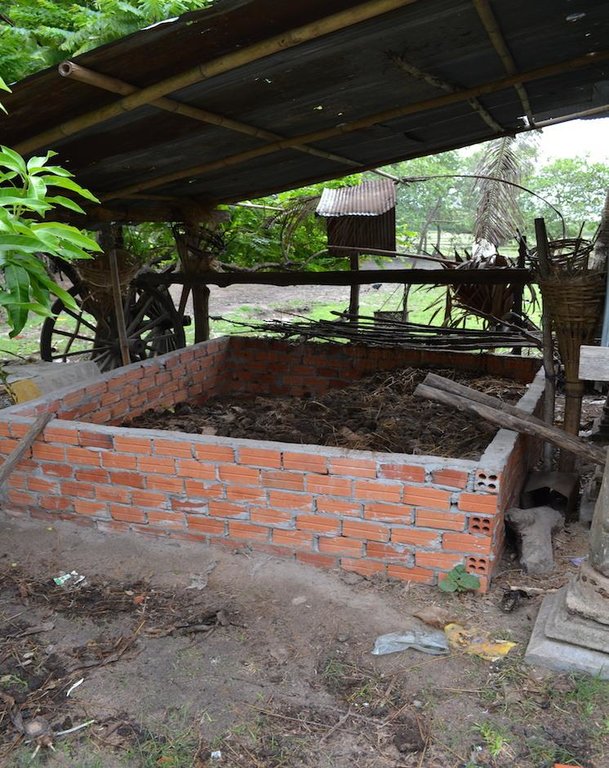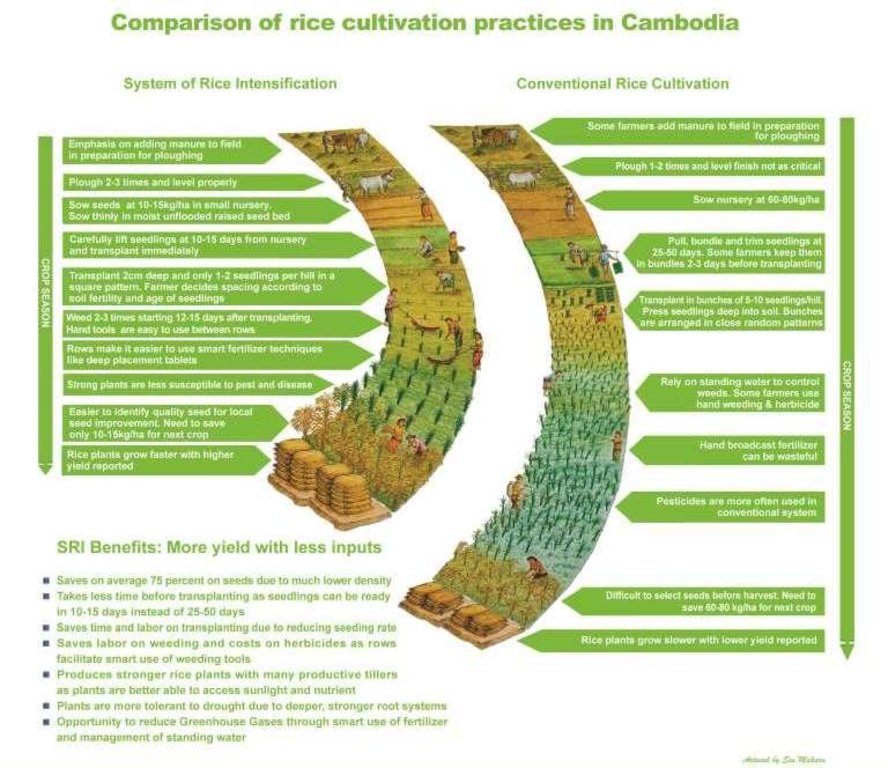Adapted System of Rice Intensification (SRI) principles in Kampong Chhnang [ប្រទេសកម្ពុជា]
- ការបង្កើត៖
- បច្ចុប្បន្នភាព
- អ្នកចងក្រង៖ Christoph Kaufmann
- អ្នកកែសម្រួល៖ –
- អ្នកត្រួតពិនិត្យ Deborah Niggli
ការទទួលយកប្រពន្ធ័ប្រពលវប្បកម្មដំណំាស្រូវក្នុងខេត្តកំពុងឆ្នំាង (Khmer)
technologies_1224 - ប្រទេសកម្ពុជា
ពិនិត្យមើលគ្រប់ផ្នែក
ពង្រីកមើលទាំងអស់ បង្រួមទាំងអស់1. ព័ត៌មានទូទៅ
1.2 ព័ត៌មានលម្អិតពីបុគ្គលសំខាន់ៗ និងស្ថាប័នដែលចូលរួមក្នុងការវាយតម្លៃ និងចងក្រងឯកសារនៃបច្ចេកទេស
អ្នកជំនាញឯកទេស SLM:
Khun Lean Hak
kleanghak@yahoo.com / sofdec@camintel.com
SOFDEC/LAREC, www.sofdec.org
អ្នកជំនាញឯកទេស SLM:
អ្នកជំនាញឯកទេស SLM:
Say Mesa
Saymesa18@gmail.com
SOFDEC
ប្រទេសកម្ពុជា
អ្នកជំនាញឯកទេស SLM:
Bin Sreytouch
Sreytouchbin@gmail.com
SOFDEC
ប្រទេសកម្ពុជា
អ្នកជំនាញឯកទេស SLM:
Pith Khonhel
khonhel@gmail.com
LAREC
ប្រទេសកម្ពុជា
ឈ្មោះអង្គភាពមួយ (ច្រើន) ដែលបានចងក្រងឯកសារ/ វាយតម្លៃបច្ចេកទេស (បើទាក់ទង)
Local Agricultural Research and Extension Centre (LAREC) - ប្រទេសកម្ពុជាឈ្មោះអង្គភាពមួយ (ច្រើន) ដែលបានចងក្រងឯកសារ/ វាយតម្លៃបច្ចេកទេស (បើទាក់ទង)
Society for Community Development in Cambodia (SOFDEC) - ប្រទេសកម្ពុជា1.3 លក្ខខណ្ឌទាក់ទងទៅនឹងការប្រើប្រាស់ទិន្នន័យដែលបានចងក្រងតាមរយៈ វ៉ូខេត
តើពេលណាដែលទិន្នន័យបានចងក្រង (នៅទីវាល)?
03/07/2014
អ្នកចងក្រង និង(បុគ្គលសំខាន់ៗ)យល់ព្រមទទួលយកនូវលក្ខខណ្ឌនានាទាក់ទងទៅនឹងការប្រើប្រាស់ទិន្នន័យដែលបានចងក្រងតាមរយៈវ៉ូខេត:
បាទ/ចា៎
1.4 សេចក្តីប្រកាសស្តីពីចីរភាពនៃការពណ៌នាពីបច្ចេកទេស
តើបច្ចេកទេសដែលបានពណ៌នានេះមានបញ្ហាដែលផ្តោតលើការធ្លាក់ចុះគុណភាពដី, បើដូច្នេះវាមិនអាចត្រូវបានប្រកាសថាជាបច្ចេកទេសនៃការគ្រប់គ្រងប្រកបដោយចីរភាពទេ?
ទេ
1.5 ការយោងទៅលើកម្រងបញ្ជីសំណួរនៃវិធីសាស្ត្រផ្សព្វផ្សាយ SLM

Model farmer [ប្រទេសកម្ពុជា]
Model farms were introduced by a NGO in order to spread knowledge about SLM (compost, System of Rice Intensification SRI, and other technologies) in the project area.
- អ្នកចងក្រង៖ Christoph Kaufmann
2. ការពណ៌នាពីបច្ចេកទេស SLM
2.1 ការពណ៌នាដោយសង្ខេបពីបច្ចេកទេស
និយមន័យបច្ចេកទេស:
Some points of the System of Rice Intensification (SRI) technology, like the row transplanting of young seedlings and the use of compost are adapted and applied in Kampong Chhnang.
2.2 ការពណ៌នាលម្អិតពីបច្ចេកទេស
ការពណ៌នា:
The System of Rice Intensification (SRI) was developed in the 1980s in Madagascar, where a French monk worked together with local farmers. The goals of the project were the improvement of the livelihoods of local farmers and the establishment of a farming system that is self-sufficient and thus needs no external inputs. SRI is not a recipe to be followed step by step, but general ideas that need to be adapted to the local conditions. These basic ideas are the following:
- Early transplanting of the seedlings, at the two-leaves-stage (less than 15 days after sowing). At this stage, the plant still has the potential to make a lot of tillers, and develop a strong root system. The seedlings are transplanted carefully, so the plant doesn’t suffer a transplanting shock.
- Wide spacing of single seedlings, usually in squares. The recommended spacing goes from 25 to 50 cm, depending on the soil fertility. This transplanting technique reduces the concurrence between the rice plants and allows the land user easier weeding.
- Aerating the soil. Rice is produced in standing water, but grows better if the roots are aerated. This is usually done with weeding, and additionally either by alternately flooding and letting the soil dry out, or by draining the water regularly. - The soil is fed with compost or manure in order to enhance the fertility and improve the soil structure.
SRI induces changes in deeply rooted local habits with some counter-intuitive knowledge like that more seeds do not produce more yields. Thus the methods have to be adapted locally and yields monitored to fit to other areas.
In Kampong Chhnang, the rice is transplanted at the six-leaves-stage, which is still earlier than conventional transplanting, with spacing of about 15 to 20 cm.
In Kampong Chhnang, the labour availability is low, as many young people work abroad or in the garment industry. Thus the SRI principles, which were taught by an NGO in 2004, were not followed completely, but adapted to this major constraint. The use of very young seedlings requires careful transplanting, which takes time. Thus the seedlings are transplanted at the 6 leaves stage. Due to the low soil fertility in the area, the optimal spacing as tested by CARDI (Cambodian Agricultural Research and Development Institute), was about 20 by 20 cm.
The rice seeds are soaked in water for 24 hours, and then let to germinate in a hot and humid place for two days. Then they are sown on the seed bed, which is prepared with compost. As there is not enough compost available for all the fields, the seedbed is the only place where compost is applied. In the fields chemical fertilizer is used. The seedlings are transplanted after 20 to 25 days (5-6 leaves) single or two per hill, in rows 15 to 20 cm apart. They are transplanted in better levelled fields than conventional transplanting, to allow the use of less water, as the seedlings are smaller than conventional. Otherwise the water management is the same as conventional; due to the lack of labour availability, the fields are not drained as proposed by the NGO 10 years ago. The field is weeded with hoes. The rice is harvested after 85 % of the panicle turned yellow, thus obtaining the best quality.
The analysed area is flat (slope < 2%), with a tropical climate (dry season from November to May and wet season from June to October), and the soils are mostly sandy or loamy. The soil has a low fertility, contains little organic matter, and acidifies. The area has been deforested a long time ago, and the groundwater table is rather high (1-2 m during the dry season, on the surface during wet season).
Due to climate change, farmers notice more erratic rainfalls, temperature rises and more recurrent droughts. Rice is the predominant crop grown in the area, since it serves as staple food (mix subsistence and commercial activities).
The increasing migration rate (the young generation leaves the villages to work in the cities, garment industry or abroad) results in a decrease of available labour force in the area which has detrimental effects on the agricultural activities. Furthermore, the civil war in the 1970s (Khmer Rouge) led to the loss of agricultural knowledge which different NGOs try to re-establish.
2.3 រូបភាពនៃបច្ចេកទេស
2.5 ប្រទេស/តំបន់/ទីតាំងកន្លែង ដែលបច្ចេកទេសត្រូវបានអនុវត្ត និងបានគ្រប់ដណ្តប់ដោយការវាយតម្លៃនេះ
ប្រទេស:
ប្រទេសកម្ពុជា
តំបន់/រដ្ឋ/ខេត្ត:
Kampong Chhnang
បញ្ជាក់បន្ថែមពីលក្ខណៈនៃទីតាំង:
Cher Kroev
2.6 កាលបរិច្ឆេទនៃការអនុវត្ត
ប្រសិនបើមិនច្បាស់ឆ្នាំ សូមបញ្ជាក់កាលបរិច្ឆេទដែលប្រហាក់ប្រហែល:
- 10-50 ឆ្នាំ
2.7 ការណែនាំពីបច្ចេកទេស
សូមបញ្ជាក់តើបច្ចេកទេសត្រូវបានណែនាំឱ្យអនុវត្តដោយរបៀបណា:
- តាមរយៈគម្រោង / អន្តរាគមន៍ពីខាងក្រៅ
មតិយោបល់ (ប្រភេទនៃគម្រោង ។ល។):
In 2004, SRI was introduced to the land user of this case study by SOFDEC. Then the farmers adapted and transformed some steps.
3. ចំណាត់ថ្នាក់នៃបច្ចេកទេស SLM
3.1 គោលបំណងចម្បង (១ ឬច្រើន) នៃបច្ចេកទេសនេះ
- ធ្វើឱ្យប្រសើរឡើងនូវផលិតកម្ម
3.2 ប្រភេទដីប្រើប្រាស់មួយប្រភេទ (ច្រើនប្រភេទ) ដែលបានអនុវត្តបច្ចេកទេស

ដីដាំដំណាំ
- ដំណាំប្រចាំឆ្នាំ
មតិយោបល់:
Major land use problems (compiler’s opinion): Lack of organic matter, lack of water retention in soil, irregularity of rainfall, low soil fertility (sandy soil), monocultures, bare soil during dry season, ploughing.
Major land use problems (land users’ perception): Low soil fertility, sandy soil with low water retention.
3.3 ព័ត៌មានបន្ថែមអំពីអ្នកប្រើប្រាស់ដី
ការផ្គត់ផ្គង់ទឹកនៅកន្លែងអនុវត្តបច្ចេកទេស:
- ទឹកភ្លៀង និងប្រព័ន្ធស្រោចស្រព
ចំនួនសារដែលដាំដំណាំក្នុងមួយឆ្នាំ:
- 1
សូមបញ្ជាក់:
Longest growing period in days: 210, Longest growing period from month to month: June-December
3.4 ក្រុម SLM ដែលបច្ចេកទេសស្ថិតនៅក្នុង
- ការគ្រប់គ្រងជីជាតិដីតាមបែបចម្រុះ
3.5 ការសាយភាយនៃបច្ចេកទេស
បញ្ជាក់ពីការសាយភាយនៃបច្ចេកទេស:
- ត្រូវបានផ្សព្វផ្សាយត្រឹមតំបន់មួយ
ប្រសិនបើបច្ចេកទេសត្រូវបានសាយភាយពាសពេញតំបន់ណាមួយ សូមកំណត់ទំហំផ្ទៃដីអនុវត្តន៍:
- 10-100 គម2
3.6 វិធានការ SLM ដែលបញ្ចូលនូវបច្ចេកទេស

វិធានការក្សេត្រសាស្ត្រ
- A1: ដំណាំ/គម្របដី
- A2: សារធាតុសរីរាង្គ/ជីជាតិដី
មតិយោបល់:
Type of agronomic measures: better crop cover, manure / compost / residues
3.7 កំណត់ប្រភេទនៃការធ្លាក់ចុះគុណភាពដីសំខាន់ៗដែលបច្ចេកទេសនេះបានដោះស្រាយ

ការធ្លាក់ចុះសារធាតុគីមីក្នុងដី
- Cn: ការថយចុះជីជាតិ និងកាត់បន្ថយបរិមាណសារធាតុសរីរាង្គ (មិនកើតឡើងដោយការហូរច្រោះទេ)
- Ca: អាស៊ីតកម្ម
មតិយោបល់:
Main causes of degradation: soil management (The soil is ploughed and left bare for weeks in the dry season), crop management (annual, perennial, tree/shrub) (Rice monocultures), over-exploitation of vegetation for domestic use (No organic matter is left on the fields), labour availability (High migration rates.), education, access to knowledge and support services (Khmer Rouge regime led to the loss of agricultural knowledge.)
3.8 ការពារ កាត់បន្ថយ ឬស្តារឡើងវិញនៃការធ្លាក់ចុះគុណភាពដី
បញ្ជាក់ពីគោលដៅរបស់បច្ចេកទេស ដែលផ្តោតទៅការធ្លាក់ចុះគុណភាពដី:
- ការការពារការធ្លាក់ចុះគុណភាពដី
- ការកាត់បន្ថយការធ្លាក់ចុះគុណភាពដី
4. បច្ចេកទេសជាក់លាក់ សកម្មភាពអនុវត្ត ធាតុចូល និងថ្លៃដើម
4.1 គំនូសបច្ចេកទេសនៃបច្ចេកទេសនេះ
ឈ្មោះអ្នកនិពន្ធ:
Luy Pisey Rith, Oxfam America, #94, Russian Boulevard, Sangkat Teuk Laak I, Khan Toul Kork, Phnom Penh, Cambodia
4.2 លក្ខណៈពិសេសនៃបច្ចេកទេស/ ពណ៌នាពីគំនូរបច្ចេកទេស
Cambodia
Date: 25.10.2011
Technical knowledge required for field staff / advisors: high
Technical knowledge required for land users: moderate
Main technical functions: increase in nutrient availability (supply, recycling,…)
Secondary technical functions: increase in organic matter
Better crop cover
Material/ species: Rice
Remarks: Single or 2 young rice seedlings per hill, in rows, space 15-20 cm
Manure / compost / residues
Material/ species: 2 – 3 t of compost for the seed bed (0.25 ha, transplanted on 1 ha), 75 kg/ha after transplanting.
Quantity/ density: 2-3 t
4.3 ព័ត៌មានទូទៅដែលពាក់ព័ន្ធនឹងការគណនាធាតុចូល និងថ្លៃដើម
កំណត់ថ្លៃឈ្នួលជាមធ្យមនៃការជួលកម្លាំងពលកម្មក្នុងមួយថ្ងៃ:
4.50
4.5 ថ្លៃដើម និងធាតុចូលដែលត្រូវការសម្រាប់ការបង្កើតបច្ចេកទេស
| បញ្ជាក់ពីធាតុចូល | ឯកតា | បរិមាណ | ថ្លៃដើមក្នុងមួយឯកតា | ថ្លៃធាតុចូលសរុប | % នៃថ្លៃដើមដែលចំណាយដោយអ្នកប្រើប្រាស់ដី | |
|---|---|---|---|---|---|---|
| សម្ភារៈ | Compost house | 1,0 | 15,0 | 15,0 | 33,0 | |
| ថ្លៃដើមសរុបក្នុងការបង្កើតបច្ចេកទេស | 15,0 | |||||
4.6 សកម្មភាពថែទាំ
| សកម្មភាព | ប្រភេទវិធានការ | ពេលវេលា/ ភាពញឹកញាប់ | |
|---|---|---|---|
| 1. | Ploughing the seed bed (either part of the paddy fields or different field) | ក្សេត្រសាស្ត្រ | 1 / year |
| 2. | Put seeds 24 hours in water | ក្សេត្រសាស្ត្រ | 1 / year |
| 3. | Cover the seeds in a warm place for incubation until they sprout (approximately 2 days, temperatures between 37-40 °C), plant the seedlings in seed bed and let them grow for about 20 - 25 days | ក្សេត្រសាស្ត្រ | 1 / year |
| 4. | Ploughing of rice paddy field | ក្សេត្រសាស្ត្រ | 2 / year |
| 5. | Pull the seedling from seed bed, row transplanting of young rice seedlings (20-25 days): 1-2 seedlings per hill, not too deep into the soil, in 1-2 cm of water. | ក្សេត្រសាស្ត្រ | 1 / year |
| 6. | Add chemical fertilizer to the paddy fields (20 days after transplanting) | ក្សេត្រសាស្ត្រ | 1 / year |
| 7. | Weed control (easier because of row transplanting), done manually | ក្សេត្រសាស្ត្រ | 2 / year |
| 8. | Harvest rice manually when plant is 85% mature. | ក្សេត្រសាស្ត្រ | 1 / year |
4.7 កំណត់ថ្លៃដើមសម្រាប់ការថែទាំ/ សកម្មភាពរបស់បច្ចេកទេស (ក្នុងរយៈពេលមួយឆ្នាំ)
| បញ្ជាក់ពីធាតុចូល | ឯកតា | បរិមាណ | ថ្លៃដើមក្នុងមួយឯកតា | ថ្លៃធាតុចូលសរុប | % នៃថ្លៃដើមដែលចំណាយដោយអ្នកប្រើប្រាស់ដី | |
|---|---|---|---|---|---|---|
| កម្លាំងពលកម្ម | labour | ha | 1,0 | 228,0 | 228,0 | 100,0 |
| សម្ភារៈ | animal traction | ha | 1,0 | 56,0 | 56,0 | 100,0 |
| សម្ភារៈដាំដុះ | seeds | ha | 1,0 | 15,0 | 15,0 | 100,0 |
| ជី និងសារធាតុពុល | fertilizer | ha | 1,0 | 55,0 | 55,0 | 100,0 |
| ជី និងសារធាតុពុល | compost/manure | ha | 1,0 | 10,0 | 10,0 | 100,0 |
| ថ្លៃដើមសរុបសម្រាប់ការថែទាំដំណាំតាមបច្ចេកទេស | 364,0 | |||||
មតិយោបល់:
Machinery/ tools: Plough; a hand weeder can be used for higher yields but not enough labour is available on the fields. 1 ha; farmer owns 2 ha; year 2014
4.8 កត្តាសំខាន់បំផុតដែលមានឥទ្ធិពលដល់ការចំណាយ
ពណ៌នាពីកត្តាប៉ះពាល់ចម្បងៗទៅលើថ្លៃដើម:
The factor affecting the costs the most is the labour. SRI is labour intensive; the farmer needs twice as much time for a SRI field than for a conventional field. This is the reason he makes only a few of the steps he was taught 10 years ago by SOFDEC.
5. លក្ខណៈបរិស្ថានធម្មជាតិ និងមនុស្ស
5.1 អាកាសធាតុ
បរិមាណទឹកភ្លៀងប្រចាំឆ្នាំ
- < 250 មម
- 251-500 មម
- 501-750 មម
- 751-1,000 មម
- 1,001-1,500 មម
- 1,501-2,000 មម
- 2,001-3,000 មម
- 3,001-4,000 មម
- > 4,000 មម
លក្ខណៈពិសេស/ មតិយោបល់លើរដូវភ្លៀង:
1486.45 mm 2013 in Kampong Chhnang
តំបន់កសិអាកាសធាតុ
- មានភ្លៀងមធ្យម
Thermal climate class: tropics. 27-35°C
5.2 សណ្ឋានដី
ជម្រាលជាមធ្យម:
- រាបស្មើ (0-2%)
- ជម្រាលតិចតួច (3-5%)
- មធ្យម (6-10%)
- ជម្រាលខ្ពស់បន្តិច (11-15%)
- ទីទួល (16-30%)
- ទីទួលចោត (31-60%)
- ទីទួលចោតខ្លាំង (>60%)
ទម្រង់ដី:
- ខ្ពង់រាប
- កំពូលភ្នំ
- ជម្រាលភ្នំ
- ជម្រាលទួល
- ជម្រាលជើងភ្នំ
- បាតជ្រលងភ្នំ
តំបន់តាមរយៈកម្ពស់ :
- 0-100 ម
- 101-500 ម
- 501-1,000 ម
- 1,001-1,500 ម
- 1,501-2,000 ម
- 2,001-2,500 ម
- 2,501-3,000 ម
- 3,001-4,000 ម
- > 4,000 ម
5.3 ដី
ជម្រៅដីជាមធ្យម:
- រាក់ខ្លាំង (0-20 សម)
- រាក់ (21-50 សម)
- មធ្យម (51-80 សម)
- ជ្រៅ (81-120 សម)
- ជ្រៅខ្លាំង (> 120 សម)
វាយនភាពដី (ស្រទាប់លើ):
- គ្រើម/ មានពន្លឺ (ខ្សាច់)
- មធ្យម (ល្បាយ, ល្បាប់)
សារធាតុសរីរាង្គនៅស្រទាប់ដីខាងលើ:
- មធ្យម (1-3%)
- ទាប (<1%)
5.4 ទឹកដែលអាចទាញមកប្រើប្រាស់បាន និងគុណភាពទឹក
នីវ៉ូទឹកក្រោមដី:
< 5 ម
ទឹកលើដីដែលអាចទាញយកប្រើប្រាស់បាន:
មិនមាន/ គ្មាន
គុណភាពទឹក (មិនបានធ្វើប្រត្តិកម្ម):
ទឹកពិសារដែលគ្មានគុណភាព (តម្រូវឱ្យមានការសំអាត)
មតិយោបល់ និងលក្ខណៈពិសេសផ្សេងៗទៀតលើគុណភាព និងបរិមាណទឹក :
Ground water table: during dry season
Availability of surface water: during dry season
5.5 ជីវៈចម្រុះ
ភាពសម្បូរបែបនៃប្រភេទ:
- ទាប
5.6 លក្ខណៈនៃអ្នកប្រើប្រាស់ដីដែលអនុវត្តបច្ចេកទេស
ទីផ្សារនៃប្រព័ន្ធផលិតកម្ម:
- ពាក់កណ្តាលពាណិជ្ជកម្ម (ផ្គត់ផ្គង់ខ្លួនឯង/ ពាណិជ្ជកម្ម
ចំណូលក្រៅកសិកម្ម:
- 10-50% នៃចំណូល
កម្រិតជីវភាព:
- មិនល្អ
- មធ្យម
ឯកជន ឬក្រុម:
- ធ្វើខ្លួនឯង/ គ្រួសារ
កម្រិតប្រើប្រាស់គ្រឿងយន្ត:
- ប្រើកម្លាំងពលកម្ម
- ប្រើកម្លាំងសត្វ
យេនឌ័រ:
- ស្ត្រី
- បុរស
សូមបញ្ជាក់ពីលក្ខណៈពាក់ព័ន្ធផ្សេងទៀតអំពីអ្នកប្រើប្រាស់ដី:
Land users applying the Technology are mainly common / average land users
Population density: 10-50 persons/km2
Annual population growth: 0.5% - 1%
Off-farm income specification: Handicrafts, factory work, remittances
5.7 ទំហំផ្ទៃដីជាមធ្យមនៃដីផ្ទាល់ខ្លួន ឬជួលគេដែលបានអនុវត្តបច្ចេកទេស
- < 0.5 ហិកតា
- 0.5-1 ហិកតា
- 1-2 ហិកតា
- 2-5 ហិកតា
- 5-15 ហិកតា
- 15-50 ហិកតា
- 50-100 ហិកតា
- 100-500 ហិកតា
- 500-1,000 ហិកតា
- 1,000-10,000 ហិកតា
- > 10,000 ហិកតា
តើផ្ទៃដីនេះចាត់ទុកជាទំហំកម្រិតណាដែរ ខ្នាតតូច មធ្យម ឬខ្នាតធំ (ធៀបនឹងបរិបទតំបន់)?
- ខ្នាតតូច
5.8 ភាពជាម្ចាស់ដី កម្មសិទ្ធប្រើប្រាស់ដី និងកម្មសិទ្ធប្រើប្រាស់ទឹក
ភាពជាម្ចាស់ដី:
- ភូមិ
- ឯកជន មិនមានកម្មសិទ្ធ
កម្មសិទ្ធិប្រើប្រាស់ដី:
- ជាក្រុម (មានដែនកំណត់)
- ឯកជន
កម្មសិទ្ធប្រើប្រាស់ទឹក:
- អាស្រ័យផលសេរី (មិនមានការកំណត់)
មតិយោបល់:
Land users have a title that is not recognized by the state
5.9 ការប្រើប្រាស់សេវាកម្ម និងហេដ្ឋារចនាសម្ព័ន្ធ
សុខភាព:
- មិនល្អ
- មធ្យម
- ល្អ
ការអប់រំ:
- មិនល្អ
- មធ្យម
- ល្អ
ជំនួយបច្ចេកទេស:
- មិនល្អ
- មធ្យម
- ល្អ
ការងារ (ឧ. ការងារក្រៅកសិដ្ឋាន):
- មិនល្អ
- មធ្យម
- ល្អ
ទីផ្សារ:
- មិនល្អ
- មធ្យម
- ល្អ
ថាមពល:
- មិនល្អ
- មធ្យម
- ល្អ
ផ្លូវ និងការដឹកជញ្ជូន:
- មិនល្អ
- មធ្យម
- ល្អ
ទឹកផឹក និងអនាម័យ:
- មិនល្អ
- មធ្យម
- ល្អ
សេវាកម្មហិរញ្ញវត្ថុ:
- មិនល្អ
- មធ្យម
- ល្អ
6. ផលប៉ះពាល់ និងការសន្និដ្ឋាន
6.1 ផលប៉ះពាល់ក្នុងបរិវេណអនុវត្តបច្ចេកទេសដែលកើតមាន
ផលប៉ះពាល់លើសេដ្ឋកិច្ចសង្គម
ផលិតផល
ផលិតកម្មដំណាំ
មតិយោបល់/ ការបញ្ជាក់:
Around 20% more yields
ហានិភ័យនៃភាពបរាជ័យរបស់ផលិតកម្ម
មតិយោបល់/ ការបញ្ជាក់:
Seedbed can be irrigated
ទឹកដែលអាចទាញមកប្រើប្រាស់បាន និងគុណភាពទឹក
តម្រូវការទឹកសម្រាប់ស្រោចស្រព
មតិយោបល់/ ការបញ្ជាក់:
The seedbed is smaller, so less irrigation is needed in the beginning of the rainy season/dry spell
ចំណូល និងថ្លៃដើម
ការចំណាយលើធាតុចូលកសិកម្ម
មតិយោបល់/ ការបញ្ជាក់:
Used half the amount of seeds
ចំណូលក្នុងកសិដ្ឋាន
បន្ទុកការងារ
ផលប៉ះពាល់ទៅលើវប្បធម៌សង្គម
សន្តិសុខស្បៀង/ ភាពគ្រប់គ្រាន់ខ្លួនឯង
មតិយោបល់/ ការបញ្ជាក់:
Crop is more tolerant to droughts. He uses less chemical fertilizer since he uses compost
ចំណេះដឹង SLM / ការធ្លាក់ចុះគុណភាពដី
មតិយោបល់/ ការបញ្ជាក់:
Knowledge about composting
ការកាត់បន្ថយជម្លោះ
contribution to human well-being
មតិយោបល់/ ការបញ្ជាក់:
SRI increased the rice yields and reduces the use of seeds.
ផលប៉ះពាល់ទៅលើអេកូឡូស៊ី
ដី
សារធាតុសរីរាង្គដី/ការបូនក្រោមដី
មតិយោបល់/ ការបញ្ជាក់:
Compost only used in seedbed
6.3 ភាពប្រឈម និងភាពរួសនៃបច្ចេកទេសទៅនឹងការប្រែប្រួលអាកាសធាតុ និងគ្រោះអាកាសធាតុ/ គ្រោះមហន្តរាយ (ដែលដឹងដោយអ្នកប្រើប្រាស់ដី)
ការប្រែប្រួលអាកាសធាតុ
ការប្រែប្រួលអាកាសធាតុ
| រដូវកាល | ប្រភេទនៃការប្រែប្រួលអាកាសធាតុ/ព្រឹត្តិការណ៍ | លក្ខណៈឆ្លើយតបនៃបច្ចេកទេសទៅនឹងការប្រែប្រួលអាកាសធាតុ | |
|---|---|---|---|
| សីតុណ្ហភាពប្រចាំឆ្នាំ | កើនឡើង | មិនស្គាល់ |
គ្រោះអាកាសធាតុ (មហន្តរាយ)
គ្រោះមហន្តរាយធម្មជាតិ
| លក្ខណៈឆ្លើយតបនៃបច្ចេកទេសទៅនឹងការប្រែប្រួលអាកាសធាតុ | |
|---|---|
| ព្យុះភ្លៀងតាមតំបន់ | ល្អ |
| ព្យុះកំបុតត្បូងតាមតំបន់ | មិនស្គាល់ |
គ្រោះមហន្តរាយអាកាសធាតុ
| លក្ខណៈឆ្លើយតបនៃបច្ចេកទេសទៅនឹងការប្រែប្រួលអាកាសធាតុ | |
|---|---|
| រាំងស្ងួត | ល្អ |
គ្រោះមហន្តរាយទឹក
| លក្ខណៈឆ្លើយតបនៃបច្ចេកទេសទៅនឹងការប្រែប្រួលអាកាសធាតុ | |
|---|---|
| ទឹកជំនន់ទូទៅ (ទន្លេ) | មិនល្អ |
ផលវិបាកដែលទាក់ទងនឹងបរិយាកាសផ្សេងៗទៀត
ផលវិបាកដែលទាក់ទងនឹងបរិយាកាសផ្សេងៗទៀត
| លក្ខណៈឆ្លើយតបនៃបច្ចេកទេសទៅនឹងការប្រែប្រួលអាកាសធាតុ | |
|---|---|
| កាត់បន្ថយពេលដាំដុះ | មិនស្គាល់ |
6.4 ការវិភាគថ្លៃដើម និងអត្ថប្រយោជន៍
តើផលចំណេញ និងថ្លៃដើមត្រូវបានប្រៀបធៀបគ្នាយ៉ាងដូចម្តេច (ទស្សនៈរបស់អ្នកប្រើប្រាស់ដី)?
រយៈពេលខ្លី:
វិជ្ជមាន
រយៈពេលវែង:
វិជ្ជមានខ្លាំង
តើផលចំណេញ និងការថែទាំ/ ជួសជុលត្រូវបានប្រៀបធៀបគ្នាយ៉ាងដូចម្តេច (ទស្សនៈរបស់អ្នកប្រើប្រាស់ដី)?
រយៈពេលខ្លី:
វិជ្ជមាន
រយៈពេលវែង:
វិជ្ជមានខ្លាំង
មតិយោបល់:
The building of the compost house (only establishment cost) was subsidized, so he had to pay only 5 $ to build it. On the long term the addition of compost is very positive for the soil fertility.
6.5 ការទទួលយកបច្ចេកទេស
ក្នុងចំណោមគ្រួសារទាំងអស់ដែលអនុវត្តបច្ចេកទេស តើមានប៉ុន្មានគ្រួសារដែលចង់ធ្វើដោយខ្លួនឯង ដោយមិនទទួលបានសម្ភារៈលើកទឹកចិត្ត/ប្រាក់ឧបត្ថម្ភ?:
- 10-50%
មតិយោបល់:
67% of land user families have adopted the Technology with external material support
33% of land user families have adopted the Technology without any external material support
20 land user families have adopted the Technology with external material support
10 land user families have adopted the Technology without any external material support
Due to the lack of labour force less farmers are applying the SRI technology.
6.7 ភាពខ្លាំង/ គុណសម្បត្តិ/ ឱកាសនៃបច្ចេកទេស
| ភាពខ្លាំង/ គុណសម្បត្តិ/ ឱកាសនៅកន្លែងរបស់អ្នកប្រើប្រាស់ដី |
|---|
| Improved soil structure and fertility due to the compost addition. |
| ភាពខ្លាំង/ គុណសម្បត្តិ/ ឱកាស ទស្សនៈរបស់បុគ្គលសំខាន់ៗ |
|---|
| Improved yields (ca. 20%) |
| Better price possible if he applied SRI without chemical fertilizer and if he sold the yield on the organic market. |
6.8 ភាពខ្សោយ/ គុណវិបត្តិ/ ហានិភ័យនៃបច្ចេកទេស និងវិធីសាស្ត្រដោះស្រាយ
| ភាពខ្សោយ/ គុណវិបត្តិ/ ហានិភ័យ ទស្សនៈរបស់អ្នកប្រើប្រាស់ដី | តើបច្ចេកទេសទាំងនោះបានដោះស្រាយបញ្ហាដូចម្តេច? |
|---|---|
| The seedlings have to be treated with care. | More yields, less dependent on off-farm income. |
| Increases the workload. | Change the local agriculture to more perennials and animals to produce more organic matter (shift toward integrated farming). |
| SRI needs more compost than is available. |
| ភាពខ្សោយ/ គុណវិបត្តិ/ ហានិភ័យ ទស្សនៈរបស់អ្នកចងក្រងឬបុគ្គលសំខាន់ៗ | តើបច្ចេកទេសទាំងនោះបានដោះស្រាយបញ្ហាដូចម្តេច? |
|---|---|
| The fields are always flooded, thus there are anaerobic conditions in the root area. | Either, the water can be drained before the rain, or the fields can alternatively be dried out and flooded. |
| The seedlings are much older at the 6 leaves stage than recommended by SRI. | Experiment with transplanting of younger seedlings. |
7. ឯកសារយោង និងវេបសាយ
7.1 វិធីសាស្ត្រ/ ប្រភពនៃព័ត៌មាន
- តាមការចុះទីវាល ការស្រាវជ្រាវនៅទីវាល
- ការសម្ភាសន៍ជាមួយអ្នកប្រើប្រាស់ដី
7.2 ឯកសារយោងដែលបានចេញផ្សាយ
ចំណងជើង អ្នកនិពន្ធ ឆ្នាំ ISBN:
List of documentation about SRI in English
មានប្រភពមកពីណា? ថ្លៃដើមប៉ុន្មាន?
http://sri.ciifad.cornell.edu/extmats/index.html#english (free)
ការតភ្ជាប់ និងម៉ូឌុល
ពង្រីកមើលទាំងអស់ បង្រួមទាំងអស់ការតភ្ជាប់

Model farmer [ប្រទេសកម្ពុជា]
Model farms were introduced by a NGO in order to spread knowledge about SLM (compost, System of Rice Intensification SRI, and other technologies) in the project area.
- អ្នកចងក្រង៖ Christoph Kaufmann
ម៉ូឌុល
គ្មានម៉ូឌុល





